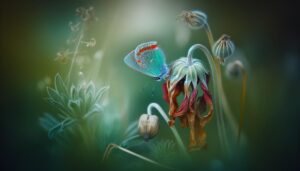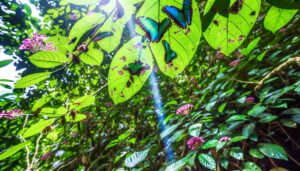How Does OE Affect Butterflies?
Ophryocystis elektroscirrha (OE) is a protozoan parasite primarily affecting monarch and queen butterflies. Infection starts when larvae ingest spores on contaminated milkweed, leading to internal proliferation during metamorphosis.
Infected butterflies suffer reduced body mass, impaired flight, and deformed wings, compromising their overall fitness and survival. Transmission occurs via spore-laden surfaces and direct contact, greatly impacting populations.
Diagnostic methods include microscopic examination and quantitative PCR. Prevention involves creating sanitized rearing environments and habitat restoration.
Detailed exploration into OE's lifecycle and transmission reveals its profound impact on Lepidopteran conservation.
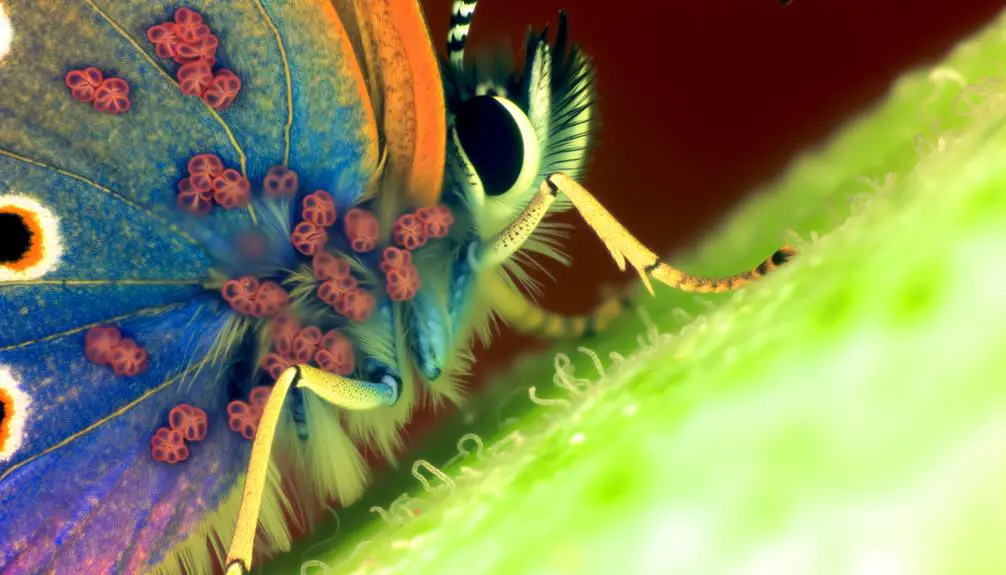
Key Takeaways
- OE (Ophryocystis elektroscirrha) is a parasitic protozoan infecting monarch and queen butterflies.
- Infection causes reduced body mass, deformed wings, and impaired flight in butterflies.
- OE is transmitted through the ingestion of spores on contaminated milkweed plants.
- Infected butterflies exhibit shorter lifespans and higher mortality rates due to OE-induced weakness.
Definition of OE
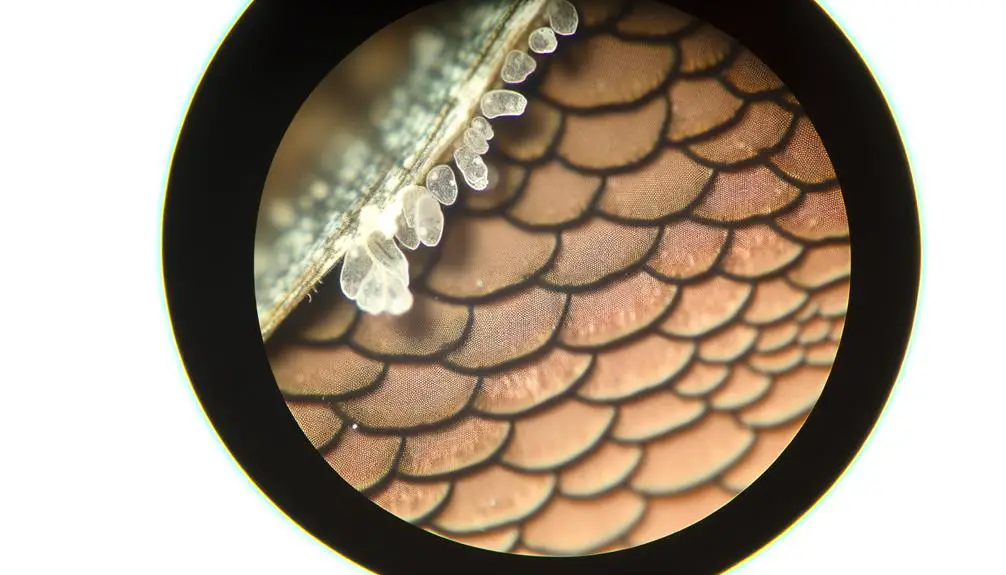
Ophryocystis elektroscirrha (OE) is a protozoan parasite that specifically infects monarch and queen butterflies, causing significant detriments to their health and survival.
Characterized by its spore-forming capability, OE disrupts various physiological processes in its host. Transmission occurs primarily through the ingestion of spores deposited on milkweed, the primary larval food source.
Upon ingestion, spores germinate in the larval gut, proliferating as the butterfly matures. Infested butterflies exhibit symptoms such as reduced body mass, impaired flight capability, and decreased reproductive success.
The lifecycle of OE is tightly linked to the developmental stages of its host, making it a formidable parasite. Understanding OE's impact on butterfly populations is essential for conservation efforts and maintaining ecological balance.
History of OE Discovery
Initial observations of Ophryocystis elektroscirrha (OE) in butterflies were made by lepidopterists who noted unusual spore formations on Monarch butterflies.
Subsequent research breakthroughs in the mid-20th century revealed the parasitic nature of OE and its detrimental impact on host butterflies, leading to increased mortality and reduced fitness.
Methodical investigations have since elucidated the lifecycle of OE and its transmission pathways, considerably advancing our understanding of this parasite.
Initial Observations Made
The discovery of OE, or Ophryocystis elektroscirrha, in butterflies dates back to the mid-20th century, when researchers first noted the presence of unusual spore-producing structures on the wings and bodies of infected Monarch butterflies.
Initial observations involved meticulous microscopic examinations revealing spore clusters primarily on the abdomens and wings. These structures, later identified as resting spores, were indicative of a parasitic protozoan infecting the host.
Field studies and laboratory analyses confirmed the spores' persistence across butterfly generations. Researchers observed deformities in severely infected individuals, such as lethargy and malformed wings, which were meticulously documented.
The early identification of these symptoms paved the way for further investigations, establishing a foundational understanding of OE's impact on butterfly populations.
Research Breakthroughs Achieved
Subsequent research breakthroughs elucidated the complex life cycle of Ophryocystis elektroscirrha and its modes of transmission among Monarch butterfly populations. By employing meticulous microscopic examination and genetic sequencing, scientists uncovered critical insights into the parasitic dynamics of OE. These discoveries highlighted the importance of understanding OE for conservation efforts.
Key findings include:
- Vertical Transmission: Infected females deposit OE spores on their eggs, leading to larval infection.
- Horizontal Transmission: OE spores are spread through contaminated milkweed leaves, infecting larvae.
- Impact on Longevity: OE considerably reduces the lifespan and migratory ability of infected Monarchs.
- Environmental Factors: Climatic conditions and habitat quality influence OE prevalence and severity.
These findings underscore the necessity of targeted conservation strategies to mitigate OE's impact on Monarch populations.
OE Life Cycle
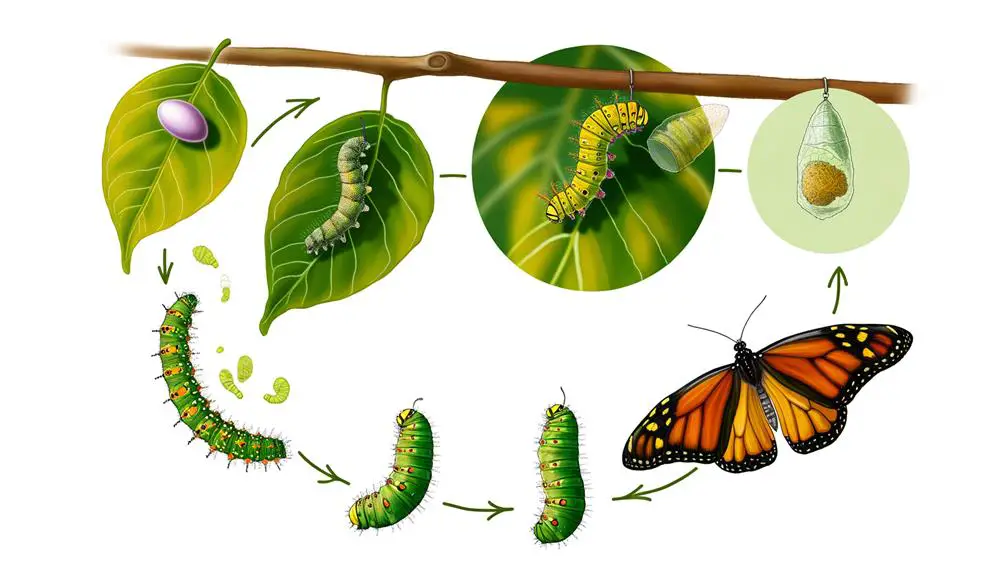
Understanding the OE life cycle in butterflies requires a detailed examination of the pathogen's transmission, replication, and impact on its host.
Ophryocystis elektroscirrha (OE) is a protozoan parasite infecting butterflies, particularly monarchs. The OE spores adhere to the egg surface, and upon hatching, larvae ingest these spores.
Inside the larval gut, the spores penetrate the gut wall, entering the host's body cavity, where they reproduce asexually. As the butterfly undergoes metamorphosis, OE multiplies, forming new spores.
These spores are present on the adult butterfly's scales and abdomen, ready to infect the next generation. The OE infection can lead to reduced fitness, impaired flight, and decreased lifespan, greatly impacting butterfly populations.
Transmission of OE
Transmission of Ophryocystis elektroscirrha (OE) in butterflies primarily occurs through direct contact with contaminated surfaces, such as host plants, or through vertical transmission from infected adult females to their offspring.
The spores of OE adhere to the butterfly’s body, especially the abdomen, and are transferred to milkweed leaves during oviposition. Upon hatching, larvae ingest these spores, leading to internal infection. Additionally, adult butterflies can spread spores through physical contact during mating or communal roosting. As the infection progresses, heavily infected butterflies may struggle with weakened flight ability and reduced lifespan. This can impact their migratory success and influence where butterflies go during rain or adverse weather conditions, as weaker individuals may seek more sheltered areas. Over time, the persistence of spores in the environment contributes to the ongoing transmission of the parasite within butterfly populations.
The implications of OE transmission are profound and often emotional:
- Reduced Survival Rates: Infected larvae often fail to reach adulthood.
- Weakened Adults: Infections lead to compromised flight capabilities.
- Population Decline: High infection rates can decimate localized populations.
- Ecosystem Impact: The decline of butterfly populations affects pollination dynamics.
Symptoms in Butterflies
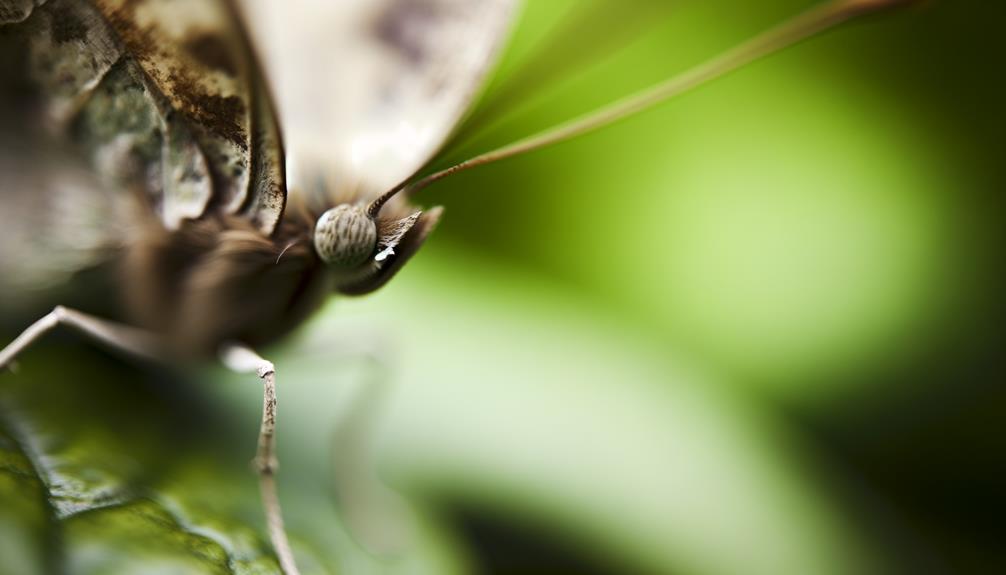
Infected butterflies often exhibit a range of symptoms including reduced body size, deformed wings, and impaired flight ability.
Detailed observations reveal that these physical anomalies result from the parasitic infection caused by Ophryocystis elektroscirrha (OE). The compromised wing structure typically manifests as crumpled or misshapen wings, hindering effective flight.
In addition, infected larvae often exhibit stunted growth, culminating in smaller adult butterflies. The parasitic load can also impair the butterfly's ability to emerge properly from the chrysalis, leading to incomplete eclosion.
Further, infected individuals may demonstrate lethargy and reduced vigor. These symptomatic manifestations not only impact the physical attributes but also compromise the overall fitness and survivability of the affected butterflies.
Impact on Monarchs
The impact of Ophryocystis elektroscirrha (Oe) on monarch butterflies (Danaus plexippus) is multifaceted, contributing greatly to population decline through reduced lifespan and reproductive success.
Disease transmission occurs primarily via spores on contaminated host plants, leading to high infection rates among larval and adult stages.
Addressing this issue necessitates targeted conservation efforts, including habitat restoration and minimizing exposure to infected milkweed.
Monarch Population Decline
Recent studies have shown a significant decline in the monarch butterfly population, primarily attributed to the prevalence of the parasitic protozoan Ophryocystis elektroscirrha (OE). This parasitic infection has had adverse effects on the health and survival rates of monarchs, resulting in widespread population decreases.
Detailed observations have identified several critical impacts:
- Reduced Lifespan: Infected monarchs often exhibit shortened lifespans, compromising their ability to reproduce.
- Impaired Flight: OE infection leads to weakened wing integrity, hindering migration capabilities.
- Lowered Reproductive Success: Infected females lay fewer viable eggs, exacerbating population decline.
- Increased Mortality in Larvae: Larval stages experience higher mortality rates due to OE-induced weakness.
These factors collectively underscore the severe impact OE has on monarch populations.
Disease Transmission Routes
Frequently, disease transmission routes of Ophryocystis elektroscirrha (OE) in monarch butterflies are facilitated through direct contact with contaminated surfaces, such as milkweed leaves where adult females deposit their eggs.
The spores of OE adhere to the female's abdomen and are subsequently transferred to the oviposited eggs and surrounding foliage.
Larvae ingest these microscopic spores during feeding, leading to the development of an internal infection.
The pathogenic lifecycle culminates when adult butterflies emerge covered in spores, perpetuating the transmission cycle.
Additionally, close proximity within nectar sources and communal roosting sites exacerbates the spread of OE.
These transmission dynamics underscore the importance of understanding environmental and behavioral factors contributing to the prevalence of this debilitating protozoan parasite.
Conservation Efforts Needed
Addressing the impact of Ophryocystis elektroscirrha (OE) on monarch butterfly populations necessitates targeted conservation efforts informed by rigorous scientific research and ecological monitoring. Such efforts should focus on mitigating the spread of OE and bolstering monarch resilience.
Key strategies include:
- Habitat Restoration: Establishing and maintaining milkweed-rich habitats to support healthy breeding grounds.
- Public Education: Raising awareness about OE and promoting best practices for butterfly gardening and habitat conservation.
- Monitoring Programs: Implementing systematic tracking of OE prevalence in monarch populations across migratory routes.
- Research Funding: Securing sustained financial support for studies investigating OE's lifecycle, transmission pathways, and potential treatment methods.
These initiatives are essential for preserving monarch populations and ensuring their long-term survival amidst increasing ecological challenges.
Diagnosing OE
Diagnosing Ophryocystis elektroscirrha (OE) in butterflies involves meticulous examination of their scales and fecal matter for the presence of the protozoan spores.
Utilizing a microscope, researchers can scrutinize scale samples scraped from the butterfly's abdomen, where spores typically adhere. Additionally, fecal matter is collected from larvae to detect early-stage infections.
The spores, which are distinguishable by their unique oval shape and refractive qualities, are counted to assess infection severity. Quantitative PCR (qPCR) may be employed for higher precision in spore quantification.
This systematic approach guarantees accurate diagnosis, which is critical for understanding infection dynamics and implementing appropriate conservation measures.
Accurate diagnosis aids in differentiating between healthy and infected populations, therefore guiding more informed ecological decisions.
Prevention Strategies
Implementing effective prevention strategies for Ophryocystis elektroscirrha (OE) necessitates a thorough understanding of the butterfly's life cycle and habitat requirements.
Analyzing these factors allows for targeted interventions that can mitigate the spread of OE.
Key strategies include:
- Sanitizing Rearing Environments: Regularly clean and disinfect enclosures to eliminate OE spores.
- Rotating Milkweed Plants: Use multiple milkweed patches and rotate them to reduce contamination.
- Monitoring Butterfly Populations: Frequently check butterflies for OE symptoms to catch early signs of infection.
- Educating the Public: Raise awareness about OE and its prevention among butterfly enthusiasts and conservationists.
These measures, grounded in scientific observation, are critical to preserving butterfly populations and maintaining ecological balance.
Treatment Options
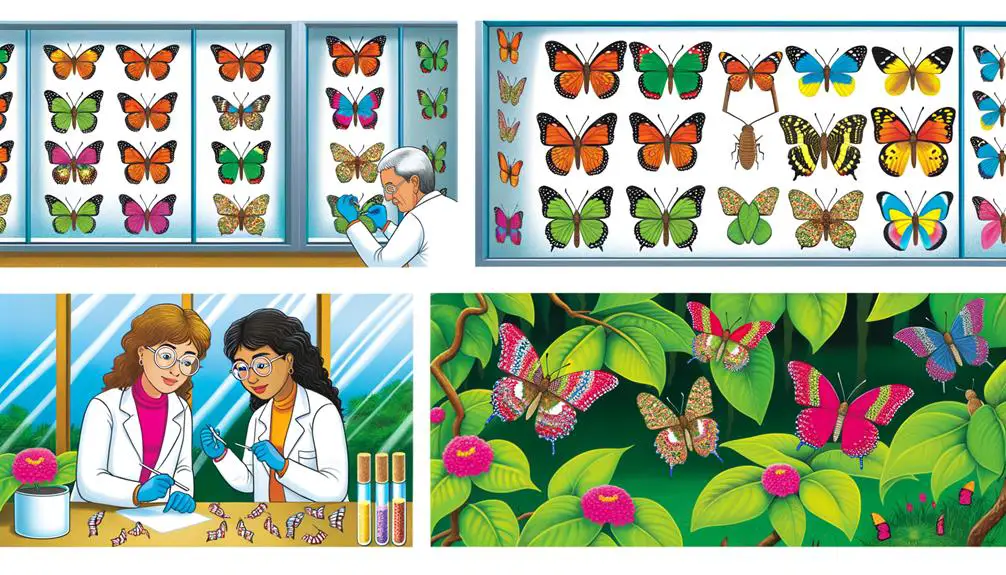
Effective treatment options for Ophryocystis elektroscirrha (OE) in butterflies necessitate a multifaceted approach, combining both chemical and non-chemical methods to manage and reduce the parasitic load.
Chemical treatments often involve the use of antimicrobial agents that target the spore stage of the parasite, though their efficacy varies.
Non-chemical methods include meticulous sanitation of rearing environments to prevent spore transmission and implementing quarantine measures for newly acquired specimens.
Additionally, heat treatment of butterfly habitats can be utilized, as OE spores are susceptible to elevated temperatures.
A balanced diet fortified with immune-boosting supplements may also enhance the butterflies' natural defenses.
These strategies, employed collectively, offer an extensive framework for mitigating OE infections in butterfly populations.
Conservation Efforts
Conservation efforts to mitigate the impact of Oe in butterflies encompass a multifaceted approach, including habitat preservation strategies, targeted breeding program initiatives, and extensive public awareness campaigns.
Habitat preservation is critical to maintaining genetic diversity and reducing the spread of Oe by providing stable environments.
Additionally, breeding programs aim to enhance resistant populations, while public awareness campaigns educate communities on the importance of butterfly conservation and the steps they can take to help.
Habitat Preservation Strategies
One of the critical habitat preservation strategies for butterflies involves the restoration and maintenance of native plant species that serve as crucial resources for their lifecycle stages. This approach guarantees butterflies have access to necessary nectar sources, host plants for larvae, and overwintering sites.
Detailed observations highlight the importance of creating and protecting diverse habitats, which enhance butterfly populations.
To evoke a sense of urgency and commitment, consider the following:
- Species Decline: Over 50% of butterfly species are threatened by habitat loss.
- Pollination Dependency: Butterflies contribute considerably to the pollination of numerous flowering plants.
- Biodiversity Indicator: Butterfly population health reflects broader ecosystem vitality.
- Conservation Efforts: Effective habitat preservation can reverse population declines, fostering ecological balance.
These strategies are crucial for sustainable butterfly conservation.
Breeding Program Initiatives
To complement habitat preservation strategies, establishing robust butterfly breeding programs is imperative for bolstering population numbers and genetic diversity.
These initiatives focus on controlled environments to monitor and manage breeding pairs, ensuring ideal disease-free conditions. Specifically, breeding programs aim to mitigate the spread of Ophryocystis elektroscirrha (Oe) by selecting and mating only healthy individuals.
Extensive genetic assessments are conducted to maintain heterogeneity and resilience against pathogens. The larvae are reared in meticulously sanitized enclosures, minimizing exposure to contaminants.
Upon reaching maturity, butterflies are released into their natural habitats to enhance local populations. This methodical approach not only augments population numbers but also strengthens genetic pools, providing a buffer against environmental stresses and disease outbreaks.
Public Awareness Campaigns
Effective public awareness campaigns are paramount in fostering community engagement and support for butterfly conservation efforts.
These campaigns elucidate the significance of combating Ophryocystis elektroscirrha (Oe), a debilitating protozoan parasite affecting various butterfly populations. By disseminating scientifically accurate information, such initiatives can lead to meaningful behavioral changes and policy support.
Key emotional touchpoints include:
- Loss of Biodiversity: Highlighting the potential extinction of butterfly species.
- Ecological Balance: Emphasizing the role of butterflies in pollination and ecosystem health.
- Future Generations: Stressing the importance of preserving natural heritage for children and grandchildren.
- Citizen Science: Encouraging public participation in monitoring and data collection.
These elements can galvanize collective action, ensuring the survival of these essential pollinators.
Conclusion
To summarize, Ophryocystis elektroscirrha (OE) represents a significant threat to butterfly populations, akin to a shadow cast over their vibrant wings.
Understanding its lifecycle, transmission, and symptoms is imperative for effective diagnosis and intervention.
Preventative strategies and treatment options must be rigorously implemented to mitigate its impact.
Conservation efforts play a pivotal role in safeguarding these delicate insects, ensuring the continuity of their ecological contributions.
The battle against OE requires a methodical and scientific approach to preserve butterfly biodiversity.

